
Xenophyophorea is a clade of foraminiferans. Members of this class are multinucleate unicellular organisms found on the ocean floor throughout the world's oceans, at depths of 500 to 10,600 metres. They are a kind of foraminiferan that extract minerals from their surroundings and use them to form an exoskeleton known as a test.

Foraminifera are single-celled organisms, members of a phylum or class of amoeboid protists characterized by streaming granular ectoplasm for catching food and other uses; and commonly an external shell of diverse forms and materials. Tests of chitin are believed to be the most primitive type. Most foraminifera are marine, the majority of which live on or within the seafloor sediment, while a smaller number float in the water column at various depths, which belong to the suborder Globigerinina. Fewer are known from freshwater or brackish conditions, and some very few (nonaquatic) soil species have been identified through molecular analysis of small subunit ribosomal DNA.

An abyssal plain is an underwater plain on the deep ocean floor, usually found at depths between 3,000 and 6,000 metres. Lying generally between the foot of a continental rise and a mid-ocean ridge, abyssal plains cover more than 50% of the Earth's surface. They are among the flattest, smoothest, and least explored regions on Earth. Abyssal plains are key geologic elements of oceanic basins.
The abyssal zone or abyssopelagic zone is a layer of the pelagic zone of the ocean. The word abyss comes from the Greek word ἄβυσσος (ábussos), meaning "bottomless". At depths of 4,000–6,000 m (13,000–20,000 ft), this zone remains in perpetual darkness. It covers 83% of the total area of the ocean and 60% of Earth's surface. The abyssal zone has temperatures around 2–3 °C (36–37 °F) through the large majority of its mass. The water pressure can reach up to 76 MPa.
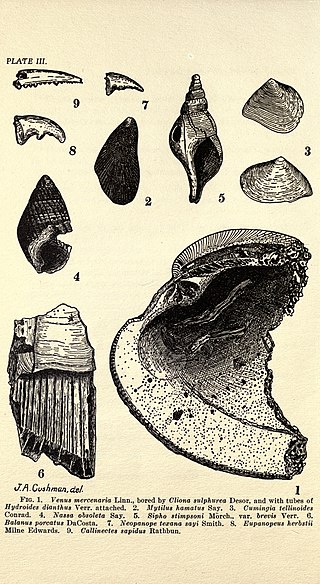
Joseph Augustine Cushman was an American micropaleontologist and academic. He specialized in the study of marine protozoans (foraminifera) and became the foremost foraminiferologist of the first half of the twentieth century, develping to a "world-famous system of discovering petroleum deposits". He also was a founding father of Kappa Delta Phi fraternity.
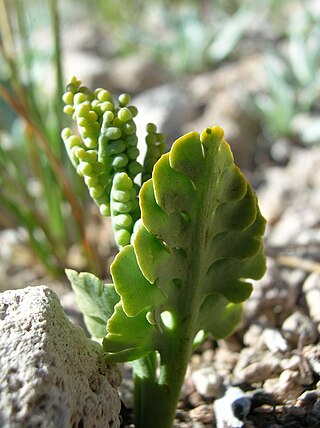
Botrychium pumicola, with the common name pumice moonwort, is a rare fern.

The large-billed tern is a species of tern in the family Laridae. It is placed the monotypic genus Phaetusa. It is found in most of South America. It has occurred as a vagrant in Aruba, Bermuda, Cuba, Panama and the United States. Its natural habitats are rivers and freshwater lakes.
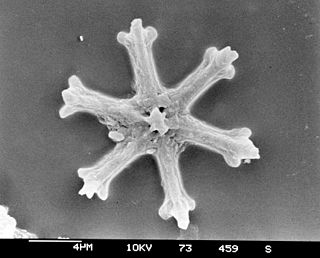
Discoaster is a genus of extinct star-shaped marine algae, with calcareous exoskeletons of between 5-40 μm across that are abundant as nanofossils in tropical deep-ocean deposits of Neogene age. Discoaster belongs to the haptophytes. About 100 species can be recognized.
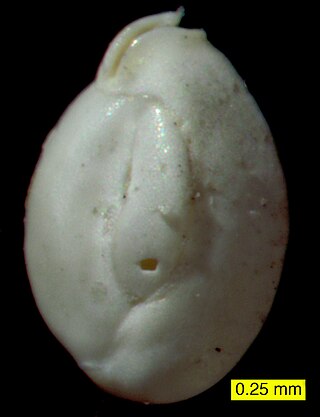
Quinqueloculina is a genus of foraminifera in the family Miliolidae.
Globigerinoides is an extant genus of shallow-water planktonic foraminifera of family Globigerinidae. First appearing in the Oligocene these foraminifera are found in all modern oceans. Species of this genus occupy the euphotic zone, generally at depths between 10-50m, in waters which cover a range of salinities and temperatures. They are a shorter lived species, especially when compared to Globorotalia genus. As a genus Globigerinoides is widely used in various fields of research including biostratigraphy, isotope geochemistry, biogeochemistry, climatology, and oceanography.

Oneirophanta mutabilis is a species of sea cucumbers in the family Deimatidae. It is the type species of the genus Oneirophanta. It is found on the seabed at abyssal depths. It was first described by the Swedish zoologist Hjalmar Théel in 1879, being one of the many deep sea animals discovered during the Challenger expedition of 1872–1876.
Alfred R. Loeblich Jr (1914–1994) was an American micropaleontologist. He was married to Helen Niña Tappan Loeblich and the two co-authored a number of important works on the Foraminifera and related organisms.

Occultammina is a genus of xenophyophorean foraminifera known from the Atlantic and Pacific oceans. It is notable for being the first known infaunal xenophyophore as well as for being a possible identity for the enigmatic trace fossil Paleodictyon.

Foraminiferal tests are the tests of Foraminifera.
Nothia is an extinct genus of foraminifera described in 1964 by Pflaumann, belonging to the subfamily Bathysiphoninae and containing 5 species.
Lana is a genus of foraminifera described in 1977 belonging to the family Komokiidae. It contains three species.

Iridia is a genus of foraminifera belonging to the subfamily Tholosininae. It contains four species. The first species, I. diaphana, was discovered in the Querimba archipelago by scientists Edward Heron-Allen and Arthur Earland, who first described the genus in 1914.
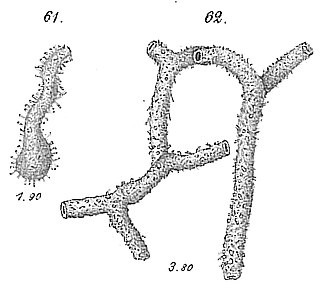
Saccorhiza is a genus of foraminifera belonging to the subfamily Saccorhizinae and containing 18 species. Its type species was discovered by H.B. Brady and described as Hyperammina ramosa in 1879, but was later separated into its own genus in 1899.

Saccarina is a monotypic fossil genus of agglutinated benthic foraminifera described in 1969, belonging to the subfamily Saccorhizinae. It contains the sole species Saccarina bitubulifera. Its chronostratigraphic range is the Ludlovian, during the Upper Silurian.

Lamina is a monotypic fossil genus of agglutinated foraminifera belonging to the subfamily Ammomarginulinae. It contains the sole species Lamina irreperta, described in 1972.















